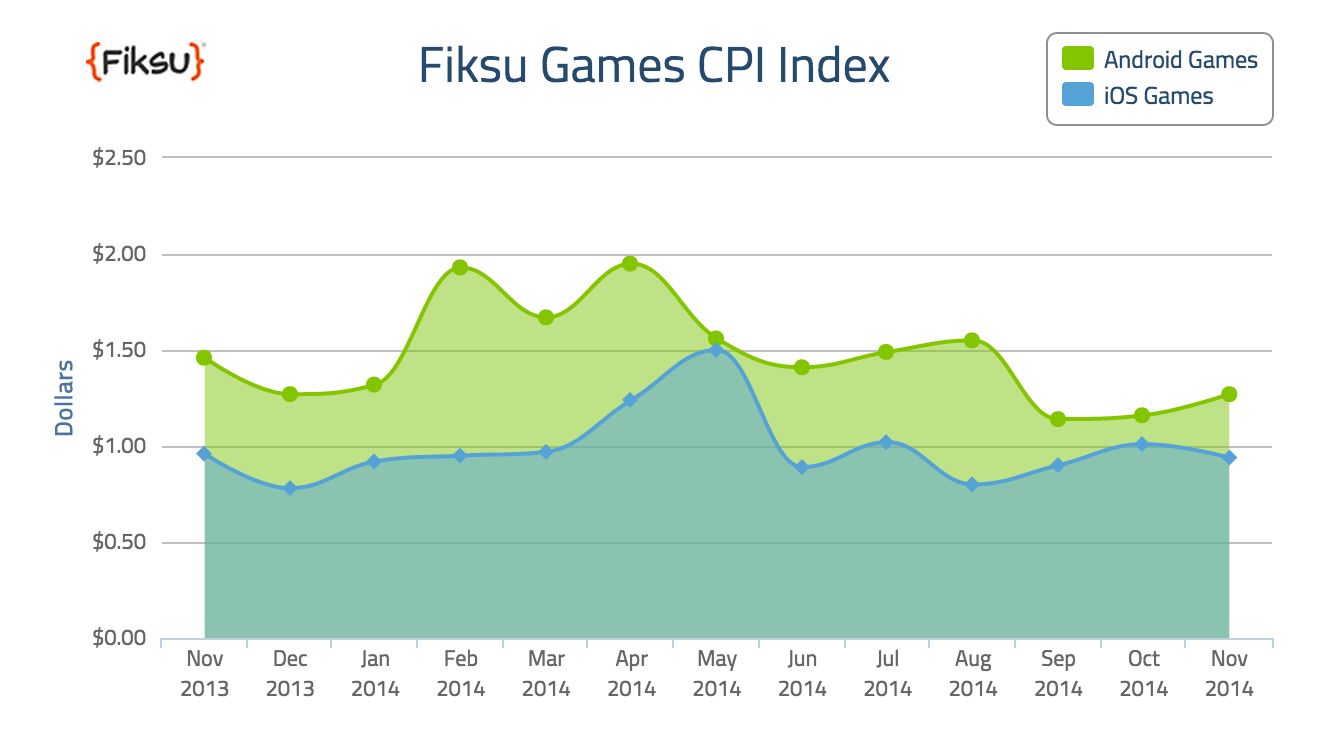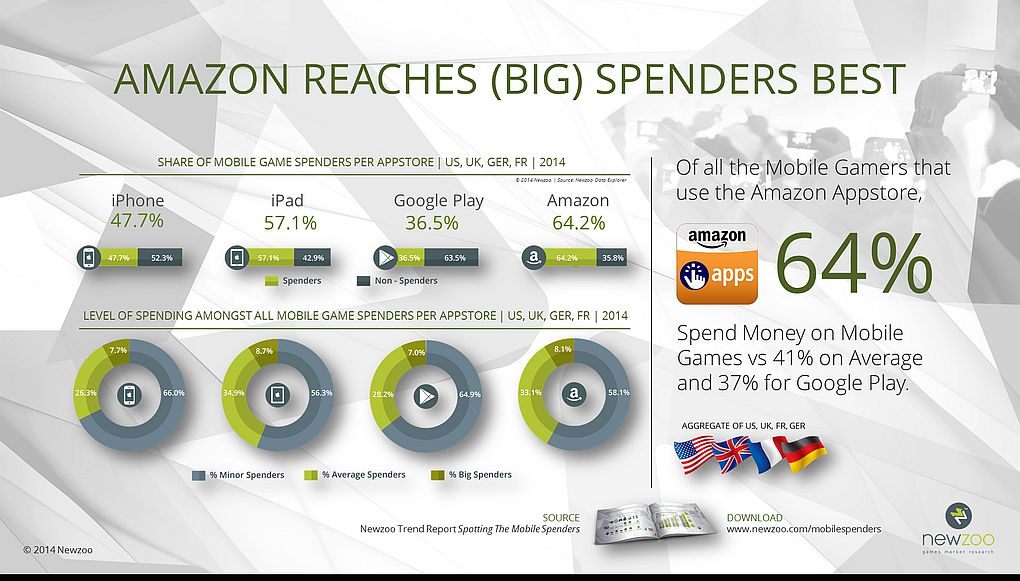By Glenn Kiladis
SVP, New Media Solutions & Games Evangelist at Fiksu
Apple recently released its top grossing apps for 2014, and the top three are all, not surprisingly, games. Gaming represents the largest percentage of time spent on mobile devices, and we don’t see that changing anytime soon. However, there are some things we do expect to change in 2015 that will impact mobile marketing strategies for games companies.
Those factors include:
- Increased spend from big brands
- Focus on audience targeting
- Retargeting & deep linking
- Programmatic buying
- Cross-platform gaming
- Rise of phablets & advancements in OS
We’ll look at each of these in more detail.
CPI Trends
Fiksu’s Cost Per Install (CPI) Index measures the cost per app install directly attributed to advertising. As you can see in the chart below, for much of the last year, Android games costs have remained consistently higher than iOS games costs – primarily due to significant spending on lower-cost incentivized networks for iOS games, which has a different impact on Android. We expect this trend to continue into 2015.
However, we also expect games CPIs on both platforms to be impacted by some key factors looming for 2015. For starters, as we’ll discuss later, big brands are finally putting more money into mobile. These brands have big budgets, and they’re not as price sensitive as other marketers. This increased pressure from brands is expected to drive up costs for everyone on mobile, including game marketers.

At the same time, however, marketers are increasingly focused on leveraging Programmatic Real-Time Bidding (RTB), which offers access to a large scale of display and video ad inventory with greater efficiency through the use of machine learning optimization. Marketers can focus the optimization technology around in-app monetization events like social shares, subscriptions or in app purchases to find the “traffic that matters”. This “Rise of the Machines” could put downward pressure on overall costs and increase the performance of a mobile marketing dollar.
In either case, the important thing to remember is that CPI is not the most important metric for mobile marketers. As our past research has shown, low CPIs don’t mean anything if those users don’t deliver a positive ROI. Alternatively, high CPIs can result in large returns if they produce high-quality users. More and more, we’re seeing ROI-driven marketing become the norm, and we expect that to continue into 2015.
Pressure from Brands
As mentioned, brands are finally beginning to embrace mobile as a part of their digital strategy. For instance, Taco Bell recently had a big push to promote its new mobile app, and they’re not alone. As this trend continues into 2015, increased mobile spending from brands will gobble up more inventory and increase user acquisition costs for everyone else, including games.
In addition, as traditional and digital first brands begin to strengthen their presence on mobile, this will also increase competitiveness in iOS App Store rank for everyone on mobile, including game marketers.
“As a result of this growing trend, ‘ok’ UA strategies that have worked in the past won’t cut it anymore.”
As a result of this growing trend, “ok” UA strategies that have worked in the past won’t cut it anymore. Brands and games will be competing for the same inventory, and ultimately, something’s going to have to give. Game companies do however, have a head start over brands and could maintain their edge leveraging data, smarter audience buying, retargeting and all the mobile ad-tech tools available.
Audience Targeting
As more robust mobile data becomes available, marketers across the board are increasingly gaining opportunities to reach highly specific audiences at scale. While this strategy has been most intriguing to brand marketers, the capabilities will undoubtedly prove highly beneficial to game marketers as well.
Previously, many mobile game marketers were most interested in acquiring low cost loyal users, with less focus on and visibility into the characteristics of those users. While that may still be the primary goal, now, mobile game marketers will really be able to hone in on the characteristics of the specific audience that monetizes best for them, and go after those highly targeted users.
To make this possible, there will be an increased emphasis on the value of both 1st and 3rd party mobile data. Combined, they create an extremely rich dataset which can allow game marketers to refine their mobile marketing spend. With this capability, game marketers can identify, target and programmatically buy against an audience as specific as males, 18-24, with at least 3 mid-core games downloaded on their device-instead of just trying to display ads where that audience tends to be. While it will cost more initially to reach these highly targeted segments, the users will be more likely to monetize, therefore driving increases in ROI.
Retargeting
“In fact, for one popular social casino game, retargeting was able to more than double the number of purchasers acquired purely through user acquisition strategies.”
2015 is likely to be the year of retargeting, particularly when it comes to gaming. Retargeting was recently characterized as being “where the puck is headed” by Marc Hale, Re-engagement Sales Lead at Twitter. In fact, Hale noted that “The majority of the money being spent on mobile retargeting is coming from the mobile gaming community…gaming companies are ‘mobile first’ and they know the lifetime spend of their customers, and they can see the whole customer sales funnel.”
Through our own experience at Fiksu, we’ve seen gaming companies as early adopters of mobile retargeting-and they’ve been seeing success. In fact, for one popular social casino game, retargeting was able to more than double the number of purchasers acquired purely through user acquisition strategies.
Using the latest in deep linking technology, future retargeting ads will feel less like advertisements, as they drive users to a specific location within the game. As mobile game marketers become more familiar with this strategy, many will realize that it should play an ongoing role in their marketing campaigns. There are so many instances where retargeting can be beneficial: from reminding a user to open the app after installing it, to encouraging them to register, to trying to get them to make in-app purchases. Retargeting is definitely where the puck is headed, and it’s travelling fast.
Programmatic Buying
As mobile advertising costs rise, it will continue to become more important to make sure that every penny spent is being done so wisely. Through programmatic buying, which incorporates closed-loop feedback (within milliseconds) into an automated decision-making process, marketers can leverage machine learning to be sure that their dollars are being spent as efficiently as possible.
“While not purely specific to the gaming industry, programmatic buying, and in particular real-time bidding, will be increasingly popular if recent trends are any indication”
While not purely specific to the gaming industry, programmatic buying, and in particular real-time bidding, will be increasingly popular if recent trends are any indication. According to Smaato, global mobile real time bidding (RTB) spend increased 140 percent year-over-year from Q3 2013 to Q3 2014. And that growth isn’t expected to slow. According to eMarketer, RTB (on desktop and mobile) is predicted to grow from $4.16 billion in 2013 to $11.84 billion in 2016, a 185 percent increase.
Cross-platform Gaming
One growing trend that will be unique to gaming is a growing emphasis on a cross-platform experience and marketing strategy. One great example of this is Activision, which recently released an iPad version of its game Skylanders: Trap Team that is identical to the console version.
For Activision, a cross-channel marketing strategy has been key to driving the success of this game in a time when player habits are shifting rapidly. They’ve been among the first to take advantage of the full capabilities of mobile gaming, but they won’t be the last. According to Newzoo, mobile gaming revenue is expected to surpass that of console games next year, as it tops $30 billion in 2015. As this happens, game publishers will need to be able to truly extend their reach across multiple platforms, and have a mobile marketing strategy to compliment that increased emphasis on the mobile gaming experience.
“Despite the potential it seems to offer, Metal has not yet had a major impact on the industry: per Apple, only 12 of the hundreds of thousands of games in the App Store are currently incorporating it”
We expect more of these console-quality gaming experiences to come to iOS thanks to Apple’s iOS 8 feature “Metal.” Metal is a new technology that helps developers create console-like gaming experiences by enabling them to maximize the graphics and computing potential of their iOS app. Despite the potential it seems to offer, Metal has not yet had a major impact on the industry: per Apple, only 12 of the hundreds of thousands of games in the App Store are currently incorporating it. Look for that number to change dramatically over 2015.
The Rise of Phablets & Advancements in Operating Systems
Larger smartphones, aka “phablets”, like the new iPhone, Nexus, and Samsung devices, along with the continued evolution of mobile operating systems like iOS 8, will likely fuel monetization improvements in the coming year. While better gameplay probably isn’t the primary driver behind the size increases and new technologies, anyone who’s played a high-end game on an iPhone 6 Plus or a Samsung Galaxy S5 knows that they really do improve the gaming experience.
The enhanced experiences these devices offer are likely to result in users spending more time, and consequently more money, playing mobile games. With UA costs potentially rising as previously mentioned, these potential monetization improvements could help lessen the blow of the higher UA costs.
What This All Means to You
Now that you know what to expect in the year ahead, how can you take that knowledge to make sure you have the best mobile marketing strategies in place for 2015 The most important thing to be prepared for is fluctuations in costs: don’t depend on costs staying where they are today.
“you should know what these costs mean to you. If you have to pay $2 or even $4 for an install, but that user spends $10 in your game, it’s worth it”
That said, you should know what these costs mean to you. If you have to pay $2 or even $4 for an install, but that user spends $10 in your game, it’s worth it. As we said, the key to remember is that CPI doesn’t tell the whole story and shouldn’t be the only metric you’re using to measure success in your campaigns.
After that, you want to be sure you’re embracing the use of data and maximizing some of the newer mobile ad-tech capabilities that will help you drive increases in revenue, namely audience targeting and retargeting. Generally, you need an established mobile gamer base before getting started (or massive desktop gamer base for cross-screen retargeting), but as long as you have that, you should be trying to drive increased engagement with your game. As mentioned, this could mean reminding users who have downloaded your app to come play, or encouraging users who have registered to make their first in-app purchase.
You also want to be sure you’re buying as much media as possible programmatically, and maximizing the technology, use of audience targeting, reach and low costs available through RTB. Also, as you look to amplify your gamer acquisition or retargeting using Twitter and Facebook, look for companies like Fiksu that apply programmatic buying to social.
And finally, larger smartphones are changing the game, both literally and figuratively. You should be making sure your game is capitalizing on the increased functionality, and that you’re upping your marketing efforts to make sure users are aware of these enhancements.
You should also be on the lookout for other upcoming trends, including a stronger focus on video, as well as App Store chart inflation.
2015 promises to be an excited year for advancements in mobile game marketing. While marketing strategies, costs, and mobile ad inventory could be impacted by pressure from big brands and massive digital first companies, there’s a lot to look forward to on the horizon. I wish all of you a happy, healthy and prosperous 2015. It’s going to be a fun ride.Â
Glen Kiladis is SVP, New Media Solutions & Games Evangelist at Fiksu
Republished from GamesIndustry International. For more, read GamesIndustry International for the latest in game industry news, opinions, interviews, and key information about the global games industry.
 Level 257 concept drawing (photo credit: Chicago Tribune)
Level 257 concept drawing (photo credit: Chicago Tribune)

